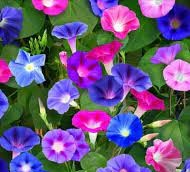September Birth Flower: The Story of Aster & Morning Glory”
The best Flowers to grow in your garden. September has two birth flowers; the Aster and the Morning Glory.
What is the September birth flower? These flowers typically bloom at their peak growing season, and offering enough variety to tailor birthday flowers in a personalized ways. For example, you can choose different flower types, including whether you enjoy the early morning mood! But flowers come in a wide range of colors and varieties, each flower has its own symbolism and the meanings of its colors of that flower!
So you can see how a bit knowledge about September birth flower can help you craft a thoughtful, personalized birthday bouquet!
The two birth flowers for September are Asters and Morning Glories, both flourishing in the crisp air of early fall-off and expressing the fragrance of the sinking, summer days. Asters, with their star-shaped blooms, come in different shades that similar to sunset colors.
Whereas, Morning Glories thrive in the fresh, drizzly mornings. The tradition of connecting flowers with birth months dates back to ancient Rome and has since spread universally, with two flowers chosen to define monthly.

Key Points of September Birth Flower
The birth flowers for September are, Aster and Morning Glory. They each have their own nature and meanings:
- Aster symbolize love, wisdom, beauty, and faith. They comes in many colors, including pink, red, white, lilac, and mauve.
- Each color of an aster has its own significance. For instance, red aster represent deep love.
- Morning glories also symbolize love and affection but blooming only for one day.
- Basically, this flower comes from China and Japan but now grow in many places around the world. In ancient China, this flower was also used for medicinal purposes.
- People born in September can use these meanings to understand more about their birth flowers!

Primary September Birth Flower
Aster: September Birth Flower

Description: Asters are flowering plants that belong to Asteraceae family, which also includes daisies and sunflowers. They have a central disk surrounded by a number of slender petals, creating a star-like shape. The Asteraceae family is one of the largest group of plants and involves above 23,000 species. Asters are grouped into several types, including New England asters, New York asters, and European Michaelmas daisies.
Planting: The ideal place for Asters; cool, moist summers and cool nights with full to partial sunlight. In warm weather, they do not like exposure to the intense midday sun. The soil should be loamy, well-draining, and consistently moist. Before planting, mix 2 to 3 inches of compost into the soil to improve its quality.
When to Plant Asters
- The ideal time to put young aster plants is mid- to late spring after the risk of frost has passed.(See local frost dates.)
- Another option, you can plant mature, potted asters, usually available at garden centers in late summer or early fall.
- Asters can also be grown from seed, although germination might be uneven. If liked, plant seeds in the fall or start them indoors during winter.
How to Plant Asters
- When planting young asters outside in the spring, space them 1 to 3 inches apart, depending on the type and their mature size.
- Fully grown asters, usually available in late summer or early fall, should be planted at around 3 feet apart.
- If planting seeds, sow them 1 inch deep in pots or flats and then refrigerate them 4 to 6 weeks to mimic winter dormancy. This cold period will start germination.
- Water thoroughly and spread mulch around the plants to keep the soil cool and prevent weeds.
Growth habit: Asters are everlasting plants with a bushy, upright, growth design. Depending on the type, they typically grow 1-6 feet (30-180 cm)high and 1-3 feet (30-90 cm) width. Their leaves are lance-shaped or linear and are normally arranged alternately along the stem.
Flowers: Asters produce an plenty of daisy-like blooms with a central disk and a number of slender petals. The central disk is usually yellow, whereas, the petals come in different colors like, white, pink, purple, red, and blue.
Blooming Season: Asters usually bloom from late summer to early fall, presuming color in the garden when many other plants have already finished flowering.
Hardiness: Asters are hardy plants mostly, they can be grown in USDA zones 4-8 and it’s depend on the variety.
Sunlight and Soil: Asters can grow fast in full sun to light shade and needs well-drained soil.
Garden Uses: Asters are typically used in mixed borders, cottage gardens, and cutting gardens, and they also serve as a nectar source for pollinators like butterflies and bees.
Common Pests/Diseases:
Pests: Aphids, foliar nematodes, slugs, snails, and Tarsonemid mites.
Diseases: Aster yellows, Botrytis blight, fungal leaf spot, powdery mildew, rust, Rhizoctonia root and stem rot, white smut, Fusarium wilt, and Verticillium wilt.
History: Asters have a long history dating back to old times, they were valuable because of their beauty and medicinal properties. The name “aster” comes from the Latin word “astrum”. This means “star”. There are numerous types of Aster flowers, and they are more than just pretty flowers. People also used asters in medicine to treat aliments such as coughs, colds, and digestive issues.
Special Features: They are very special. These star-shaped Flowers have a secret. Asters can talk with bees and butterflies in their way! These little flowers send signals only bees and butterflies can see. Not just that, a few people even believe burning aster leaves will keep save them by bad spirits.
Secondary September Birth Flower
Morning Glory: September Birth Flower

Description: Morning glories are flowering plants belonging to the Convolvulaceae family. They are familiar for their trumpet-shaped blooms that comes in different colors such as, blue, purple, pink, red, and white.
Planting: Morning Glories need full sun to bloom their best! So, select a sunny spot. That place is best for Morning Glory where they can receive ample sunlight. Plant in moderately fertile, well-draining soil to promote healthy foliage and plenty of flowers. Next, choose a spot shielded from strong, drying winds. Give support like fence, lattice, or trellis for the vines to climb, preventing them from other ground-level plants.
When to Plant Morning Glories:
Plant seeds as soon as possible after the risk of frost has passed.
How to Plant Morning Glories:
- Seedlings should appear within a week, although some seeds may take 2-3 weeks to sprout.
- To improve germination rates, gently file the seeds to weaken their outer coat and then soak them in water for 24 hours before planting. This helps them to send out a root, which resembles a tiny worm.
- Cover lightly about 1/4-inch deep in soil. Spacing them at around 6 inches apart.
- Water thoroughly after planting.
Growth habit: These flowers are fast-growing, annual or perennial vines that can high 6 to10 feet (180 to 300 cm) or more, depending on the types. They utilize their twining stems to climb and cover fences, trellises, or other standing pillar.
Flowers: These flowers are trumpet-shaped with a tubular design, measuring at around 2 to 4 inches (5 to10 cm) wide. They bloom in various colors, often with a contrasting throat.
Blooming season: Morning glories usually bloom from early summer to early fall. They open their beautiful flowers early in the morning and close up when it gets warm.
Hardiness: Morning glories easily tolerate cold and warm temperatures. They are hardy and typically grown as an annuals, but some species are perennial in tropical climates (USDA zones 9 to11).
Sunlight and soil: These flowers love the sun to partial shade and prefer well-draining soil.
Garden uses: Morning glories are known for covering fences, walls, or other vertical structures. They can be easily grown in containers and hanging baskets.
Common Pests/Diseases:
Pests:
- Aphids (They are small, sap-sucking insects that cluster on new growth.)
- Spider Mites (They are tiny arachnids can stippling on leaves and leaves may become yellow and fall off.)
- Whiteflies (They are tiny, white, flying insects that suck sap from leaves. They usually found on the undersides of leaves.)
- Leaf Miners (Larvae of specific insects that burrow into leaves, creating trails. This activity can harm plants by damaging foliage.)
- Caterpillars (They eat holes in leaves and flowers. Usually they active in the morning for target.)
- Cutworms (Larvae that eat through stems which is near the soil level, cutting off plants.)
- Thrips (They are tiny, slender insects that feed on leaves and flowers.)
Diseases:
- Powdery Mildew (Fungal disease can cause a white, powdery coating on leaves. So, they can weaken the plant.)
- Root Rot (This can caused by overwatering and usually involving fungal pathogens such as pythium or phytophthora.)
- Rust (This fungal disease can create orange, yellow, or brown pustules on leaves and can cause defoliation.)
- Leaf Spot (This can be done by fungi or bacteria and may leaf drop.)
- Fusarium Wilt (Soilborne fungal disease causing wilting and yellowing of leaves.)
- Stem Rot (This can cause stem discoloration and decay, commonly at the base.)
Prevention and Management:
- Use healthy seeds for planting to avoid introducing diseases.
- Make sure air circulation is good to prevent fungal problems.
- Give water carefully and maintain well-drained soil.
- Cut and destroy affected leaves to prevent the spread of diseases.
- Choose natural predators for use. (e.g., ladybugs for aphids)
- Rotate plants and avoid planting in infected soil.
History: Morning glories started in China and Japan. They were used for their strong ropes and as medicine. From there, they have been valued across various cultures all around the world. Now, these flower can grow almost everywhere. Each color of this flower has its meaning. For example, blue means trust, whilst, pink shows warmth and happiness.
Fact about Morning Glory: This is a unique birth flower for September. It represents the love and warmth to those people who born in September. A few morning glory species’ flowers can change color throughout the day, starting with a vibrant hue in the morning and fading to a different shade by the afternoon.
Frequently Asked Questions
What is the primary birth flower for September?Aster is the primary September birth flower.
What is the secondary birth flower for September?Morning Glory is the secondary September birth flower.
What are the thoughtful meanings and symbolism related with September birth flowers?Asters represent love, wisdom, and faith. Whereas, Morning Glories symbolize affection, mortality, and the fleeting nature of life.
How should I start my garden for planting September birth flowers?Start by enriching the soil with compost. Selecting a sunny spot, and gathering the tools and materials for planting.
What are some popular varieties of September birth flower?Beautiful September birth flowers include Asters, Morning Glories, Marigolds, Zinnias, and Cosmos. Each variety has it’s unique beauty.
How can I harvest and use September birth flowers?Harvest these flowers by cutting stems at the right length, Preserving the blooms, and use them into arrangements, bouquets, or decorative displays.
